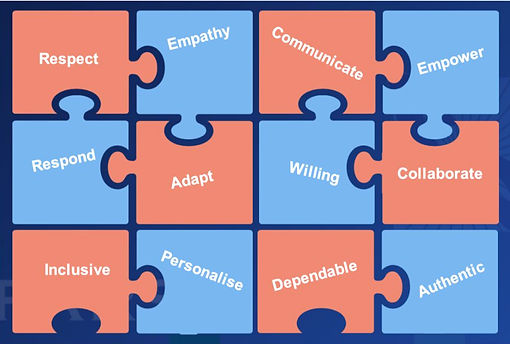Anubhava
Patient experience is often assumed to be central to hospital operations, yet it is frequently reduced to direct interactions, overlooking the broader ecosystem of touchpoints that shape a patient’s journey. This project redefined patient experience through a holistic cultural transformation, embedding patient-centric values across all hospital operations, ultimately elevating service excellence and organisational effectiveness.

Client
A Heritage Hospital Group, Karnataka, India
Timeline
18 months (2021-22)
Type of Work
Organisational Culture Change
Industry
Healthcare
Core Competencies
-
Market Research & Data Analysis
-
Focus Group design & Facilitation
-
Culture Change & Organisational Strategy
-
Copy writing & report writing
-
Workshop Design & Facilitation
-
Client & Account Management
Introduction
Culture forms the backbone of any organisation, shaping its identity and interactions. This project aimed to design a holistic, patient-centric experience for a family-run hospital chain. While patient care is central to a hospital’s purpose, extensive primary and secondary research revealed significant gaps in how it was conceptualised and implemented. While medical care was prioritised, the broader patient journey—spanning administrative processes, staff interactions, and facility design—lacked cohesion and alignment with patient needs.
The objective was to elevate the hospital chain's operations to meet the highest standards of service excellence and create a truly patient-centric experience. Over 18 months, the project aimed to redefine behaviours, decision-making processes, and service delivery models to enhance care quality and improve hospital-wide alignment with patient-first principles.
Project Brief
Process

INSIGHT & RESEARCH
Created a tailored cultural framework, aligning purpose, vision, and behaviours with organizational goals to foster growth, innovation, and patient-centric excellence.

DESIGN & STRATEGY
Created a tailored cultural framework, aligning purpose, vision, and behaviors with organizational goals to foster growth, innovation, and patient-centric excellence.

EMBED & EMPOWER
Implemented a comprehensive roadmap using strategic communication, leadership training, and behavioural change techniques to embed and sustain a resilient, patient-focused culture.
Identifying & Defining Desired Culture
To reshape the hospital’s culture into a more patient-centric model, a comprehensive research process was conducted to uncover emotional and operational gaps in the existing environment. Key activities included:
-
Focus Group Discussions: Multi-stakeholder workshops, led by the hospital chairman, utilised a modified Thematic Apperception Test to uncover emotional responses to hospital behaviours and cultural dynamics.
-
Observational Research: Fly-on-the-wall studies provided real-time insights into staff interactions and operational inefficiencies.
-
Cultural Analysis: A deep dive into organisational documentation, employee feedback, and strategic plans identified misalignments with patient-centric goals.

The design phase focused on transforming insights gathered on intangible cultural values into actionable and relatable components to drive the hospital’s cultural transformation. The Framework branded as Anubhava (ಅನುಭಾವ), meaning "experience" in Kannada. honoured the hospital’s regional heritage while serving as a guiding structure for embedding patient-centred values.
This framework formed the basis of:
-
Defining purpose, vision, and values to drive the transformation.
-
Developing a strategic narrative to communicate the culture shift.
-
Crafting an engaging communication plan, from launch to embedding.
12 Pillar Framework
Embed : Implementation Strategy
Following the establishment of the 12 Pillars Framework, the initiative was rolled out organisation-wide with a launch spearheaded by the chairman, leveraging his long-standing respect and influence among the staff. A series of town hall meetings were conducted across all branches, introducing the initiative and anchoring it firmly in the 12 pillars of patient-centric experience. Following this, a top-down strategy for implementation was adopted.
1. Leadership Buy-In
Leadership buy-in was a critical step in aligning the organisation with the new vision.
Leadership teams underwent workshops and modified psychometric assessments to clarify leadership styles, roles, establish accountability, and drive cultural transformation from the top down. By empowering leaders and creating alignment at the top level, the transformation was strategically positioned to ensure buy-in at every stage of the cultural shift.

2. Communication Rollout
Once the initiative was announced, weekly educational clips were shared across all staff and departments. These videos utilized simple visuals, accessible language, and relatable examples to effectively convey the meaning and context of the 12-pillar framework in shaping the desired culture. To accommodate linguistic diversity among the staff, the videos were designed to be easily understood through visuals alone, ensuring inclusivity and comprehension across all levels of the organisation.
Visual branding elements such as badges, signage, and posters reinforced the 12 Pillars across hospital spaces serving as continuous visual recall and integrating the pillars into the physical environment and embedding them as part of the hospital’s daily culture.
3. Training & Development
A comprehensive training program was implemented to empower staff at all levels
-
Leadership Training: Department heads underwent "train-the-trainer" sessions, equipping them with the skills and tools to lead their teams through the culture shift.
-
Staff Development: Over 1,000 employees participated in three-day intensive bootcamps conducted in small groups of 30-40. Each staff member received a custom-designed handbook, complete with reading materials and practical tools for continuous learning, ensuring the cultural framework was deeply understood and consistently applied.




4. Organisational Re-structuring
To ensure the cultural transformation was sustainable, a Patient Experience Manager (PEM) role was introduced at a later stage to champion and monitor patient care standards.
Additionally, the 12-pillar framework was integrated into a competency-based performance system, aligning staff KPIs with the desired cultural behaviours. This approach ensured measurable outcomes, regular assessments, consistent reinforcement of the patient-centric ethos and actionable guidelines for staff while establishing key metrics to evaluate success and business impact.
Impact
The project successfully embedded patient-centred values into daily operations, improving patient satisfaction and streamlining hospital processes. Leadership alignment and KPI integration ensured sustained impact, positioning the hospital as a benchmark for patient-first care. By integrating culturally resonant elements and fostering a shared commitment to excellence, the hospital redefined patient experience while creating a replicable model for healthcare transformation.

